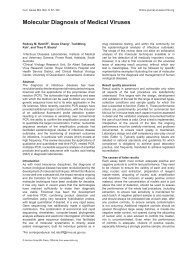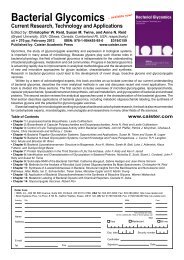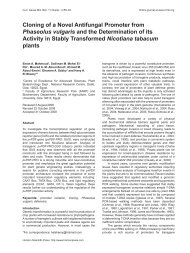Molecular Diagnostics of Medically Important Bacterial Infections
Molecular Diagnostics of Medically Important Bacterial Infections
Molecular Diagnostics of Medically Important Bacterial Infections
Create successful ePaper yourself
Turn your PDF publications into a flip-book with our unique Google optimized e-Paper software.
22 Millar et al.<br />
a. In order to prove that a certain microbe is the cause<br />
<strong>of</strong> a certain disease, that same microbe must be<br />
found present in all cases <strong>of</strong> the disease.<br />
b. This microbe must then be completely separated<br />
from the diseased body and grown outside that body<br />
in a pure culture.<br />
c. This pure culture must be capable <strong>of</strong> gibing the<br />
disease to healthy animals by inoculating them with<br />
it.<br />
d. The same microbe should then be obtained from the<br />
animals so inoculated, and then grown again in a<br />
pure culture outside the body.<br />
Koch was a great pioneer in medical microbiology<br />
and his postulates are still considered fundamental<br />
to bacteriology even today. Communicable diseases<br />
can occur in populations and cause epidemics or even<br />
pandemic problems. Some outbreak diseases are so<br />
serious that they can cause hundreds, thousands, even<br />
millions <strong>of</strong> deaths, in epidemic or pandemic proportions.<br />
For example, bubonic plague, caused by Yersinia pestis,<br />
originally spread from Asia and was carried by rat-fleas<br />
via the ports <strong>of</strong> the Black Sea to Europe, which caused 42<br />
million deaths, 25 million in Europe, in just less than five<br />
years between 1347 and 1352, reducing the population<br />
<strong>of</strong> Europe to 50 million. The scourge <strong>of</strong> tuberculosis was<br />
about to appear. Bunyon’s epithet, “The Captain <strong>of</strong> the<br />
Men <strong>of</strong> Death”, tells <strong>of</strong> the overwhelming fear that the<br />
disease was associated with, even until today. Until the<br />
present era, it was recognized and feared as one <strong>of</strong> the<br />
most common and most serious hazards <strong>of</strong> life, one from<br />
which escape was almost impossible. At the same time,<br />
the well-known Renaissance physician, Jean François<br />
Fernel was performing some early and important studies<br />
on the circulatory system. In Fernel’s book Medicini, he<br />
describes descriptions <strong>of</strong> several pathological conditions,<br />
including what is now believed to be some <strong>of</strong> the earliest<br />
published accounts <strong>of</strong> endocarditis.<br />
Comparing conventional detection methods <strong>of</strong> which<br />
have been developing over a century, molecular detection<br />
methods are relatively very young, with a history <strong>of</strong><br />
approximately no more than 20 years old. Although<br />
deoxyribonucleic acid, or DNA, was discovered in the<br />
late 1860s, it was not used until the restriction enzyme<br />
and the recombinant DNA techniques were discovered<br />
in the 1970s. During this time, many scientists worked<br />
diligently to find the pr<strong>of</strong>ound mystery <strong>of</strong> DNA. To trace<br />
the development <strong>of</strong> molecular detection methods, we<br />
should remember some pioneers and their discoveries.<br />
In 1869, Johann Friedrich Miescher, a Swiss<br />
physician, discovered a weakly acidic substance <strong>of</strong><br />
unknown function in the nuclei <strong>of</strong> human white blood cells,<br />
this substance, which was later named, deoxyribonucleic<br />
acid, or DNA. The substance was largely ignored for<br />
nearly a century because it seemed too simple to serve<br />
any significant purpose. This view changed dramatically<br />
in 1949, when Erwin Chargaff, a biochemist, reported that<br />
DNA composition was species specific; that is, that the<br />
amount <strong>of</strong> DNA and its nitrogenous bases varied from one<br />
species to another. In addition, Chargaff founds that the<br />
amount <strong>of</strong> adenine equalled the amount <strong>of</strong> thymine, and<br />
the amount <strong>of</strong> guanine equalled the amount <strong>of</strong> cytosine<br />
in DNA, from every species. During this time scientists<br />
discovered that chromosomes, which were known to carry<br />
hereditary information, consisted <strong>of</strong> DNA and proteins.<br />
In 1928, Franklin Griffith, a British medical <strong>of</strong>ficer,<br />
discovered that genetic information could be transferred<br />
from heat-killed bacteria cells to viable organisms.<br />
This phenomenon, called transformation, provided the<br />
first evidence that the genetic material is a heat-stable<br />
chemical. In 1944, Oswald Avery, a Canadian physician<br />
and bacteriologist, and his colleagues McCarty and Colin<br />
MacLeod, identified Griffith’s transforming agent as DNA.<br />
Experiments conducted throughout the 1940s showed<br />
that DNA actually seemed to be the genetic material.<br />
However, it was still not known what the structure <strong>of</strong><br />
DNA was, and how such a molecule could contain all the<br />
information needed to produce a human being or other<br />
living organisms, until 1953, when James Watson and<br />
Francis Crick discovered the molecular structure <strong>of</strong> DNA.<br />
After building successive scale models <strong>of</strong> possible DNA<br />
structures, they deduced that it must take the twistedladder<br />
shape <strong>of</strong> a double helix. The sides <strong>of</strong> the ladder<br />
consist <strong>of</strong> a “backbone” <strong>of</strong> sugar and phosphate molecules.<br />
The nitrogen-rich bases, A, T, G and C, form the “rungs” <strong>of</strong><br />
the ladder on the inside <strong>of</strong> the helix. The pair discovered<br />
that base A would only pair with T, while G would only pair<br />
with C. They were awarded the Nobel Prize in Physiology<br />
or Medicine in 1962 for their discovery, shared with<br />
Maurice Wilkins, whose work with Rosalind Franklin on Xray<br />
crystallography had provided further crucial evidence.<br />
In 1961, François Jacob and Jacques Monod develop a<br />
theory <strong>of</strong> genetic regulatory mechanisms, showing how,<br />
on a molecular level, certain genes are activated and<br />
suppressed and they were awarded the Nobel Prize in<br />
Physiology or Medicine in 1962 for their contribution.<br />
In 1961 Marshall Nirenberg, a young biochemist at the<br />
National Institute <strong>of</strong> Arthritic and Metabolic Diseases,<br />
discovered the first “triplet”—a sequence <strong>of</strong> three bases<br />
<strong>of</strong> DNA that codes for one <strong>of</strong> the twenty amino acids that<br />
serve as the building blocks <strong>of</strong> proteins. Subsequently,<br />
within five years, the entire genetic code was deciphered.<br />
At end <strong>of</strong> 1960s, almost all about the DNA structures<br />
and functions were understood in theory, but people still<br />
could not get any gene as they wanted or change any<br />
gene as they needed until 1970s when some in important<br />
enzymes were discovered. In 1970, Hamilton Smith,<br />
an American microbiologist, isolated the first restriction<br />
enzyme, an enzyme that cuts DNA at a very specific<br />
nucleotide sequence. Over the next few years, several<br />
more restriction enzymes were isolated. He shared<br />
the Nobel Prize in Physiology or Medicine with Werner<br />
Arber and Daniel Nathans in 1978 for his discovery. In<br />
1972, Paul Berg assembled the first DNA molecules that<br />
combined genes from different organisms. Results <strong>of</strong> his<br />
experiments represented crucial steps in the subsequent<br />
development <strong>of</strong> recombinant genetic engineering. In<br />
1980, Paul Berg shared the Nobel Prize in Chemistry with<br />
Walter Gilbert and Frederick Sanger, for “his fundamental<br />
studies <strong>of</strong> the biochemistry <strong>of</strong> nucleic acids, with particular<br />
regard to recombinant DNA.” In 1973, Stanley Cohen<br />
and Herbert Boyer combined their efforts to create the





